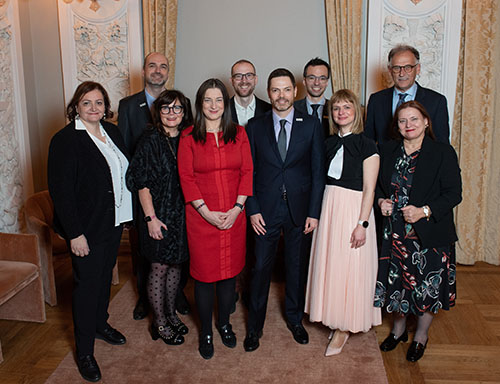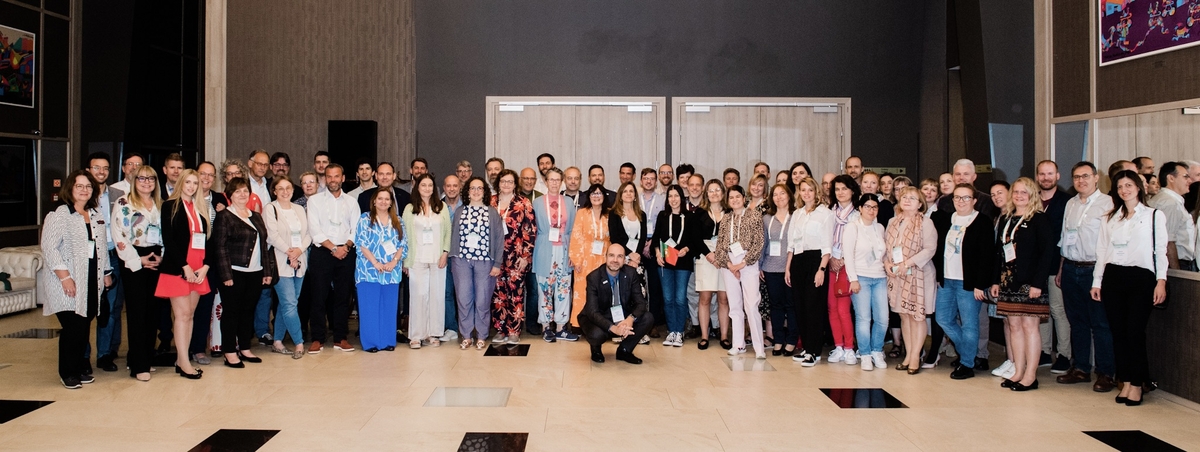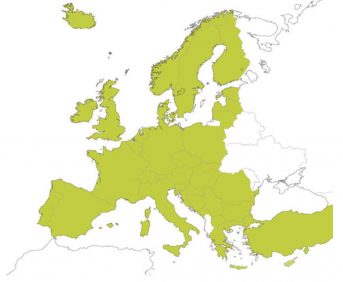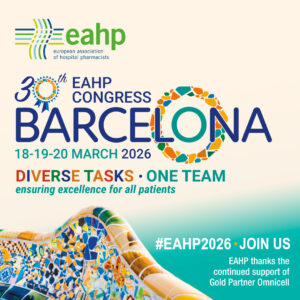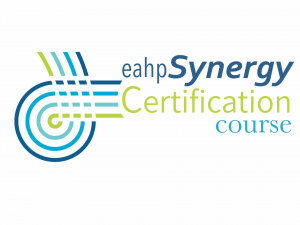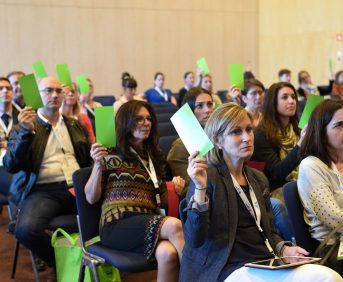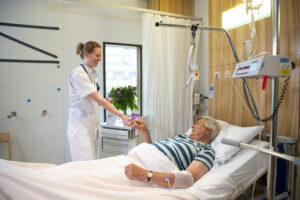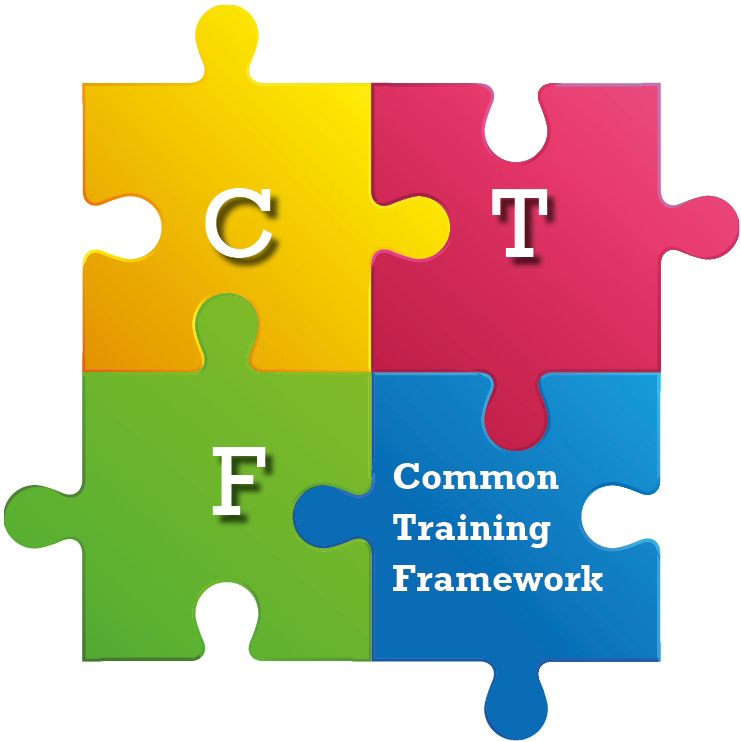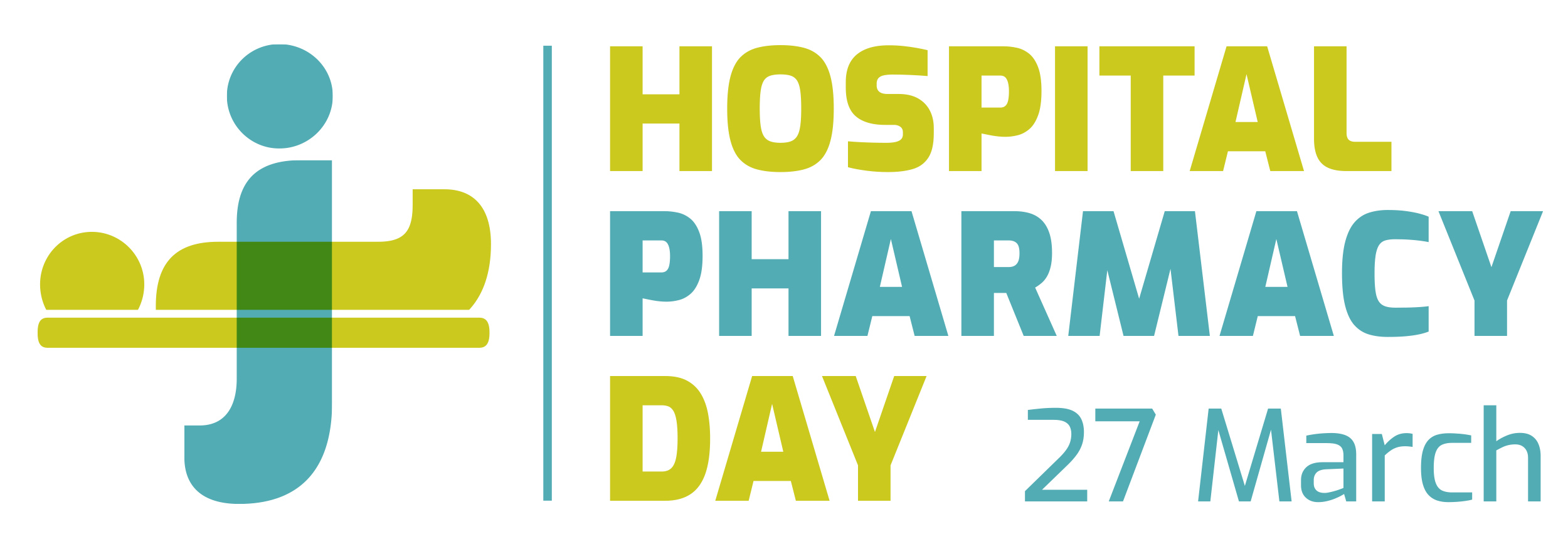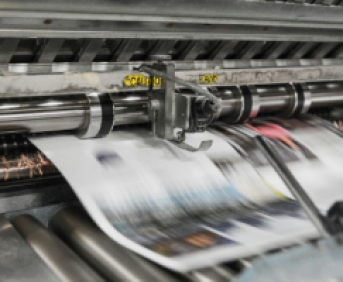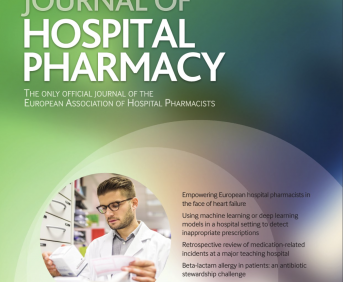SIMULATION CURVES MAY HELP TO ASSESS ANTIBIOTICS ORALISATION PROCEDURES (submitted in 2019)
European Statement
Clinical Pharmacy Services
Author(s)
Andreas von Ameln-Mayerhofer, Martin Breuling, Ina Geist
Why was it done?
In the context of antibiotic stewardship, rapid oralisation of a parenteral antibiotic is recommended in many antibiotic stewardship guidelines. Such a sequence therapy is easy to implement if both application pathways lead to comparable efficacy levels at the site of infection. However, this does not apply to all anti-infectives, in particular some beta-lactam antibiotics represent a challenge in therapy. Additionally, the information about this topic is very sparse in the literature.
What was done?
In order to achieve an improvement in antimicrobial prescriptions, we have addressed possible problems regarding oralisation of antibiotics. For this purpose, we graphically compared the simulated efficacy levels of parenteral and oral forms of beta-lactams.
How was it done?
We programmed a computer based procedure that allows a simulation of plasma levels of antibiotics upon intravenous versus oral administration. Based on the obtained data and EUCAST-based MIC-distributions for a set of bacteria, we assessed the respective putative clinical actions.
What has been achieved?
Our simulations show that some oral beta-lactams do not reach the PK/PD condition of a sufficient therapy (fT>MHK) in the approved dosage. The simulations have been used for education seminars with physicians and partly led to an improvement in oralisation procedures. Additionally, an oralisation standard has been established.
What next?
Our next step is to develop a special prescription form for oral antibiotics which will enable us to control prescription behaviour even more effectively. We plan to monitor the prescription habits for anti-infectives more closely before and after establishing the prescription form.
TOOL FOR INTERDISCIPLINARY COLLABORATION AND SHARED DECISION MAKING (submitted in 2019)
Pdf

European Statement
Clinical Pharmacy Services
Author(s)
Pernille Printzlau, Nanna Skyttegaard Mortensen, Signe Kristensen, Troels Bygum Knudsen, Nathalie King Otoo
Why was it done?
When the pharmacists make medication reviews it is often a long, detailed review with several interventions. A tool that would quickly give the physician an overview of the interventions suggested by the pharmacist was needed. Furthermore, a tool was needed in the process of shared decision making between the physician and the patient regarding the possibilities of deprescribing.
What was done?
We made a tool to improve the interdisciplinary collaboration around medication reviews and to help the process of shared decision making. The tool categorises interventions suggested by the pharmacist in red-yellow-green boxes, indicating the order of the interventions recommended by the pharmacist.
How was it done?
The tool was developed and tested by using the Model of Improvement. The physician stated that the tool gave him the needed overview and, in his experience, furthermore added value by visualising the interventions to the patient. Patients were interviewed after the consultation to evaluate how they perceived the tool and whether they felt involved in the decision making regarding their treatment and deprescribing.
What has been achieved?
A manageable and operationalisable tool for the physician to get a quick overview of the interventions suggested by the pharmacist. Furthermore, the tool visualises the interventions to the patient and supports the process of shared decision making during the consultation.
What next?
At our hospital we have clinical pharmacists making medication reviews at several different wards. The next step is to distribute the tool to pharmacists at other wards to strengthen the interdisciplinary collaboration and ensure the largest profit of the pharmacist’s medication reviews. We are also working on developing a similar tool to categorise found side effects to help the physician when deprescribing.
IMPLEMENTING A NEW PHARMACEUTICAL CARE PROCESS IN SURGERY (submitted in 2019)
Pdf

European Statement
Clinical Pharmacy Services
Author(s)
Sarah POGGIO, Anne-Sylvie DUMENIL, Sandrine ROY, Claire HENRY
Why was it done?
BPMH on admission has been performed in these departments since 2011. An analysis of the process and prescriber use of BPMH highlighted an underutilisation; average consultation rate was 29.8%. The main reasons were the online publishing interval of the BMPH and competition with the AC report which also displays medication. A previous study showed a 70% rate of patients with unintended differences between BMPH and the AC report.
What was done?
We redesigned the pharmaceutical care process for programmed patient circuits in orthopaedic and visceral surgery by providing the “best possible medication history” (BPMH) in the patient’s electronical medical record (EMR) before anaesthesia consultation (AC).
How was it done?
Due to a lack of coordination, we exchanged using surgery with anaesthesia schedules to select patients, thus improving prioritisation. We created support documents for students, describing how to conduct a phone interview in order to reassure unfamiliar patients, to gather useful data (GP, pharmacy, prescription) to produce a BPMH, to visit inpatients when admitted to confirm the BPMH’s accuracy and to assess patient satisfaction with the process. We trained 6 students and presented our work at an anaesthetist staff meeting.
What has been achieved?
Among 195 patients included from June to October 2019, 70.2% BPMH before admission were successfully published online (137/195), 67 went through the complete care path (from home to discharging), 12 never came for AC and/or surgery, 58 were published but waiting for patient’s admission and 58 failed. The reasons we failed to publish on time included inability to reach patients (31.6%), lack of sources (21.1%), time shortage before AC (17.6%), surgery cancellation (14.0%) and refusal (7.3%). 1.58 (±0.85) calls were needed to reach a patient, 13 BPMH required modification after admission (19%), and patient satisfaction on average was 5.11/6 when asked whether the call, the medication management during hospitalisation and the confirmation interview went well. Finally, the consultation rate of BMPH evolved from 29.8% in 2017 to 72% since we changed practices.
What next?
Implementing this new process in the care path streamlines information transfer between the different stakeholders (anaesthetists, surgeons, pharmacists) and provides a better integration of pharmaceutical care in surgery wards as an efficient support system for prescribers.
IMPLEMENTATION OF DRUG RECONCILIATION WITHIN THE DEPARTMENT OF PAEDIATRIC HEMATO-IMMUNOLOGY AT THE UNIVERSITY HOSPITAL CENTER ROBERT DEBRÉ (submitted in 2019)
Pdf

European Statement
Clinical Pharmacy Services
Author(s)
Marguerite VAILLANT, Sophie GUILMIN CREPON, Benoit BRETHON , Julie ROUPRET-SERZEC
Why was it done?
In order to obtain a safe patient care pathway, we wish to implement proactive and/or retroactive DR for patients followed in the Hemato-Immunology Department of the University Hospital Center Robert Debre.
What was done?
Formalise and integrate drug reconciliation (DR). Evaluate the feasibility of the project, the impact of DR on the safety of patient care and the satisfaction of patients and health professionals.
How was it done?
Prospective cohort study. The different steps are: identification of eligible patients, collection of information on the patient’s drug history and ongoing treatments from the health partners involved in his or her care, entry drug reconciliation (EDR) during the entry pharmaceutical consultation, conciliation of exit drugs during the return pharmaceutical consultation, transmission of information to the local center and pharmacist or home hospitalisation, evaluation of stakeholder satisfaction and the impact of the intervention.
What has been achieved?
Thirty patients included between August and October 2019, or 30 conciliations performed. Concerning the EDR: all hospitalisation reports and previous prescriptions are consulted (100%), 6 EDR (20%) take place in pro-active mode, the average duration of an EDR is 43 minutes. Concerning the discharge drug reconciliation (DDR): 30 DDR (100%) take place in pro-active mode, the average duration of a DDR is 52 minutes, all prescriptions and intake plans are sent to community centres and pharmacists or home hospitalisation (100%). Of all the conciliations performed: 4 sources of information used by conciliation, 11 drugs prescribed on average per prescription, 8 intentional and 6 unintentional discrepancies identified by prescription. Concerning the evaluation of satisfaction: all community centres are satisfied (100%), 26 city professionals (87%), 21 hospital professionals (70%), 27 patients (90%).
What next?
In order to ensure that DR is permanently included in the service, a communication and information tool must be developed. This, made available to the entire team, will serve as a traceability support, decompartmentalise practices and improve patient care.
MULTIDISCIPLINARY CAR-T TEAM (submitted in 2019)
Pdf

European Statement
Clinical Pharmacy Services
Author(s)
MARGHERITA GALASSI, CHIARA DELLA COSTANZA , CLAUDIA TIRONE, SARA BERTOLI, ERNESTO RUFFINO, ELEONORA FERRARI, ELENA ALIPRANDI , VITO LADISA
Why was it done?
CAR-T cell therapies are a new advanced type of personalised immunotherapy against cancer. In the EU the authorised therapies are tisagenlecleucel and axicabtagene ciloleucel, both used in our centre as third line for the registered indication of diffuse large B-cell lymphoma. CAR-T therapies production and administration process consists of multiple stages: patient’s leukapheresis, genetic engineering of lymphocytes, lymphodepleting chemotherapy (LC), CAR-T cell infusion, monitoring of the patient. Considering the complexity of the procedure and the observance of specific schedules, these therapies should be administered in highly specialised centres complying with specific organisational requirements, with disposal of an adequate multidisciplinary team.
What was done?
A multidisciplinary team (CAR-T team) was constituted for the management of CAR-T therapies (Chimeric Antigen Receptor T). The pharmacist was included in the team for the planning and organisational phase of the process.
How was it done?
The pharmacist is responsible for the approval of the physician’s prescription, the LC preparation according to Good Manufacturing Practice (GMP), the LC distribution on scheduled time, the making available of treatments for supporting the patient until CAR-T infusion, and treatments after infusion for management of adverse events. At the arrival of the CAR-T product, the pharmacist is responsible for the check and release of it in good condition. The LC protocols foresee the administration of cyclophosphamide and fludarabine on the 5th, 4th and 3rd day before the CAR-T infusion, and are defined on the basis of the summary-of-product characteristics. The medications are provided locally and refunded by the national health system.
What has been achieved?
In our center 8 patients were treated with compassionate use of axicabtagene ciloleucel. The pharmacist’s presence in the multidisciplinary team was advantageous because, through validation of the therapies and verification of dosages, they guarantee further security to the patients. The high-tech automated centralisation and computerisation of chemotherapies at our centre ensured quality and safety of the preparations.
What next?
The realisation of defined paths and codified proceedings, the respect of fundamental timings for the success of the process and the chemotherapy preparation centralisation could lead to increased investment, decisive for obtaining a high quality product and process level. The experience, now limited to haematology, could be used for future CAR-T applications.
DOES RECORDING OF MEDICATION HISTORY BY PHARMAECONOMIST IN THE EMERGENCY DEPARTMENT HAVE AN EFFECT AT OTHER HOSPITAL DEPARTMENTS? (submitted in 2019)
European Statement
Clinical Pharmacy Services
Author(s)
Maria Abrahamsen
Why was it done?
The aim of the initiative was, among others, to study whether MH by a pharmaconomist in the emergency department has positive effects in other departments. Since the majority of hospitalised patients are admitted through the emergency department it is expected that changes related to admission procedures affect other departments in the cases where patients are hospitalised. In theory recording of MH should be easy, due to the use of Shared Medication Record (FMK). FMK is an updated electronic medication list including all prescriptions filled at pharmacies within the last 2 years. In reality, often neither FMK nor the recorded MH is correct. MH recorded by pharmaconomist or pharmacist is implemented in other emergency departments, but the effect in other hospital departments has yet to be documented.
What was done?
At hospitalisation, part of the routine is to record the patient’s medicinal history. We implemented recording of medicinal history (MH) in the emergency department by a pharmaconomist instead of by a doctor.
How was it done?
The pharmaconomist was present at the emergency department weekdays during daytime to record the MH of newly admitted patients. When the pharmaconomists wasn’t present the doctor recorded the MH. To evaluate the effect in other departments, data registered by pharmaconomists at the department of geriatrics about medicinal changes, types of changes and number of patients with changes were used, combined with hospital data about the number of patients in the geriatric department at a given time. Data from 10 months before the initiative was compared with data from the 9 month test period.
What has been achieved?
At the department of geriatrics both the need for medicine changes due to inadequate MH and the number of patients with medicine changes related to inadequate MH was significantly reduced (p 0.05). The proportion of patients with changes was reduced from 43.7% to 36.9% and the number of changes per patient was reduced from 0.65 to 0.49. For both parameters the reduction is seen immediately after implementing MH by a pharmaconomist in the emergency department. The reduction has released time for nurses, doctors and pharmaconomists working outside the emergency department, though it isn’t possible to quantify the amount of released time.
What next?
Incorporation of a specialised professional such as a pharmaconomist early in a hospitalisation gives doctors, nurses and pharmaconomists working outside the emergency department extra time for other tasks. The effect of the initiative depends on the procedures for admissions since it requires that most patients are admitted through one department at the hospital.
SUCCESSFUL DEVELOPMENT OF A SHARED INFORMATION DATABASE FOR HOSPITAL PHARMACIES IN DENMARK – BENEFITING FROM AGILE PROJECT MANAGEMENT (submitted in 2019)
Pdf

European Statement
Clinical Pharmacy Services
Author(s)
Stine Ulsø, Hilde Omestad, Susanne Weng Rømer, Sisse Emilie Mejsner, Mads Nielsen, Jesper Heltoft-Christensen
Why was it done?
The existing solution, established in 2001, was running on an insecure platform, the system was expensive to maintain and changes difficult and slow to implement. The need for an update led to a change of supplier, hosting and platform.
What was done?
A new database was developed for documentation and quality assurance of drug related queries received by hospital pharmacies in Denmark. The information in the database is shared across all hospital pharmacies in Denmark and is an important tool for the Medicines Information Centers located there. Existing queries were transferred from the old to the new database.
How was it done?
A working group was established consisting of three pharmacists and superusers from three different hospital pharmacies, one project manager employed by the sponsor (Amgros) and two developers employed by the new supplier (Progressive). The project was structured using monthly physical meetings and ad hoc video conference meetings. The work tasks in the development process were divided and carried out in two-week sprints by the developers and subsequently tested and validated by the pharmacists. All participants agreed to a periodic heavy workload and showed great flexibility. The close and frequent collaboration between all members affected the teamwork in a positive way, hence the group was motivated and managed to agree on common solutions and compromises despite different database usage and different locations.
What has been achieved?
A new, stable and more intuitive database was developed in only 5 months due to the structured and flexible way of working and a close motivated teamwork. The database was taken into use from one day to another and quickly adapted. Since the development several hospital pharmacies have increased their use of the database. The amount of information shared nationally has improved.
What next?
The initiative resulted in a useful tool implemented within a short time. The way of working intensively and focused with physical meetings and video conferences made a good basis to succeed. Especially the sprint cycles can be used in different healthcare settings involving different projects.
IMPLEMENTATION OF PATIENT INTERVIEW IN CONNECTION WITH MEDICATION REVIEW IN AN INPATIENT PSYCHIATRIC WARD (submitted in 2019)
Pdf

European Statement
Clinical Pharmacy Services
Author(s)
Majken Nørskov Petersen, Dorthe Bonnerup, Louise Thorsen, Lona Louring Christrup, Sune Puggaard Vogt Straszek, Charlotte Olesen
Why was it done?
Medication review with patient interview provides the opportunity to clarify the patient’s overall drug intake along with identifying the patient’s experienced side effects. Medication review with patient interview we believe gives a more realistic picture of experienced drug related problems (DRP) and potentially DRP. This again makes the medication review more relevant and useful to the doctors.
What was done?
The initiative took place in the Department of Affective Disorders, at Aarhus University Hospital, Denmark. Initially, the medication review was performed by hospital pharmacists without patient interview based only on medical records. We implemented a patient interview to give a more clinically relevant medication review. The interview included a structured questionnaire on typical side effects of antipsychotics.
How was it done?
The cost of a new workflow is always weighed against the outcome. We therefore planned and conducted a pilot study. The cost was measured as the time used for the patient interview and it was 17 minutes on average. We used DRP as the outcome. DRP is an accessible measure for the immediate outcome of a medication review. Sixteen medication reviews without patient interview were conducted and the same 16 patients were interviewed for a second medication review. Patient interview increased the number of identified DRP from 52 to 68. Due to the interview 28 new DRP were identified and 12 DRP found before the interview were withdrawn due to irrelevance.
What has been achieved?
Patient interview has been implemented in one of three inpatient psychiatric wards and in one of four outpatient clinics where the pharmacists conduct medication review. The structured questionnaire has been further developed and now includes common side effects caused by antipsychotics, antidepressants, benzodiazepines and mood stabilizers.
What next?
We still use the pilot study to show how medication review can be more relevant by using patient interview. The hospital pharmacy in Aarhus works on several levels in order to implement medication review, preferably with patient interview.
INTEGRATION OF THE CLINICAL PHARMACIST IN A MULTIDISCIPLINARY TEAM IN A BURNS UNIT
European Statement
Clinical Pharmacy Services
Author(s)
Ángel Guillermo Arévalo Bernabé, Pilar Lalueza Broto, Jordi Serracanta Doménech, Jacinto Caparrós Baena, José Manuel Collado Delfa, Jordi Aguilera Sáez, Romy Rossich Verdés, Pablo Sánchez Sancho, Juan Carlos Juárez Giménez, Maria Queralt Gorgas Torné
Why was it done?
The burns unit of a third-level hospital includes a patient’s great heterogeneity depending on his population group and his clinical condition (extension, degree and depth of his burns, etiological agent of the burns and associated comorbidities), which makes the managing of these patients complex and they need multidisciplinary solutions. In addition, extensive burns provoke physiopatological alterations that involve changes in the pharmacokinetical and the pharmacodynamical modelling of some drugs. The knowledge that the pharmacist has about the changes that take place in vascular dynamics, the clearance and the distribution volume of the drugs, and the degree of union from these to plasmatic proteins, makes his active participation in the care of the burns patient, and in the optimisation of his pharmacotherapeutic plan, very interesting.
What was done?
The integration of the pharmacist into a multidisciplinary group of assistance to the burns patient constituted as the Managing Committee of Cases and was integrated by plastic surgery, intensive medicine, intensive paediatric medicine, preventive medicine, infectious diseases, psychiatry, psychology, social work and infirmary, as well as pharmacy.
How was it done?
A protocol was devised that standardises and systematises the review of the pharmacotherapeutic plan of all patients in the burns unit, including burn critical and paediatric. Also, there is included a model of record and codificate of pharmaceutical interventions. The multidisciplinary group meets weekly and every patient is analysed from all clinical points of view, the pharmacist intervening in relation to the pharmacotherapeutic and nutritional plan.
What has been achieved?
The active integration of the pharmacist has been achieved in the clinical group of assistance to the burns patient. In addition, there has been created a collaborative attitude that has benefited joint projects of investigation. The degree of acceptance of the offers of modification that the pharmacist realises is 90%.
What next?
The following step must be, depending on the obtained results, to establish improvement assistance measures, including the accomplishment of protocols and the development of investigation projects that help to generate knowledge about the use of some drugs in burns patients, such as immunoglobulin or proteolitic enzymes for the extraction of bed sores.
THE PHARMACIST IN THE LUNG CANCER MULTIDISCIPLINARY TEAM
Pdf

European Statement
Clinical Pharmacy Services
Author(s)
Ana Soares, Armando Alcobia
Why was it done?
Several clinical practice guidelines for LC recommend that multidisciplinary teams should be used to plan patients’ treatment. The evolution of thoracic oncology, namely the increasing knowledge of the diverse histologic and molecular phenotypes in non-small cell LC, has been driven to more complex treatment algorithms in recent years. This complexity increases the need for a multidisciplinary approach in therapeutic decision-making, which must be individualised and based on the best information available. The pharmacist’s inclusion in the multidisciplinary team is essential and was formerly proposed by the Pneumology Director to the Hospital Administration Board.
What was done?
A hospital pharmacist is a permanent member of the lung cancer (LC) multidisciplinary team, which has met weekly since January 2016, to plan the management and treatment of LC patients in our hospital. The pharmacist brings updated information about the efficacy and safety of drug treatments, its cost-effectiveness and its availability. The pharmacist improves communication with the Pharmacy and Therapeutic Committee.
How was it done?
The multidisciplinary team meets weekly to discuss the diagnosis and treatment options of LC patients, and includes a dedicated group of professionals: pulmonary oncologists, a thoracic surgeon, a radiation oncologist, a radiologist, a pathologist, a nuclear medicine specialist, a hospital pharmacist, a palliative care physician and an oncology nurse.
What has been achieved?
About 240 cases, corresponding to 200 patients were discussed per year. An average of 110 solicitations to the Pharmacy and Therapeutic Committee were made. The multidisciplinary team grants a systematic approach to diagnosis and therapeutics, in compliance with evidence-based guidelines, improves communication and coordination between professionals and short waiting times for the patient.
What next?
The next step is to systematise real-world data collecting, from the patients treated, to better understanding the effectiveness of treatment options and the real impact of the multidisciplinary team in patient outcome, ideally, extending it onto a national level.
